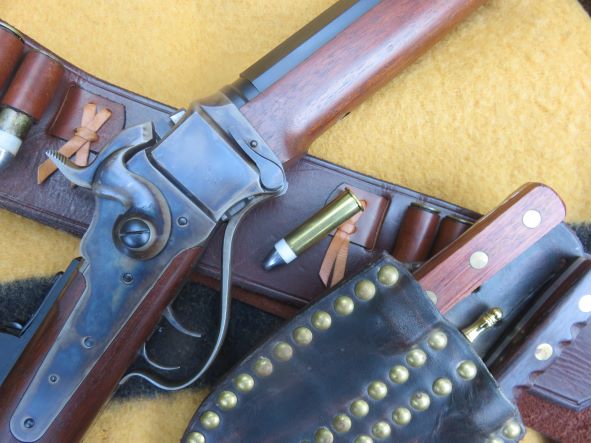
By Mike Nesbitt | Contributing Editor
For me it’s back to the .50-70 for a while.
This is being done with somewhat of a purpose and that is to make a paper patched bullet load as my standard loading for the .50-70, at least in one particular rifle. That’s not a big problem at all and the rifle, a Model 1874 Sharps by C. Sharps Arms, is equipped with a custom barrel which was made by Oregon Barrel Company (contact them through The Gun Works at www.thegunworks.com) with a 1 in 32” in rate of twist. Several of the old Sharps rifles in .50 caliber, both the .50-70 and the longer .50-90, had barrels with a 1 in 30-inch rate of twist, so the 1 in 32-inch twist isn’t far from the old-timers.
Making a paper patched bullet load for the .50-70 isn’t hard to do but the first step is to make the bullets. For this episode, over fifty slicks from a KAL (kal.castpics.net/Molds.html) adjustable mold, set to drop bullets at 473 grains, were prepared. (Paper patched bullets are sometimes called “slicks” because they are smooth sided with no lube grooves.) That was the weight of the standard bullet for the .50-90 Sharps and it was also available for the .50-70 to be used in Sharps rifles. The bullets from this mold are slightly tapered and the widest point is right at the heel of the bullet, which for these, measure .498” in diameter.
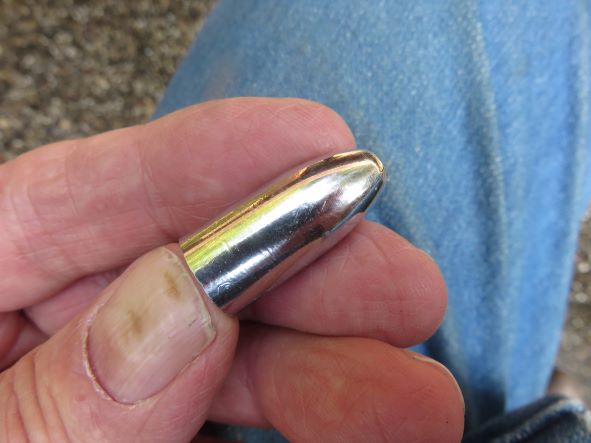
If you are interested in trying paper patched bullets with your black powder loads by all means buy some swaged bullets from Buffalo Arms Company (www.buffaloarms.com ). They can provide the swaged bullets for paper patching in several calibers, most often with different diameters to choose from for each caliber. As an example, for .50 caliber they offer the swaged bullets with diameters of either .492-inch or .504-inch. The .492 diameter might be better as a hunting load while the .504” diameter bullets should be best for target work. Buffalo Arms can also supply the patching paper and a steel paper patch template for the caliber you are working with. Trying some paper patched bullets first will certainly give you a better idea of what you want before you spring for a special bullet mold.
In fact, Buffalo Arms Company offers a .438-inch diameter bullet in several weights for the .44-77 or .44-90 Sharps. I’ll be trying some soon in my .44-77 and a report shall follow.
After getting or casting a supply of bullets, the next step is to patch them. I buy my patching paper from Buffalo Arms which is a 9-pound cotton “onion skin” paper with a thickness of .002”. This paper is sold in packs of 100 of the 8 ½ X 11” sheets and that’s enough to last a fairly long time. There are other papers available, by other vendors, but be sure that you get 100% cotton because other materials can be hard on the rifle’s bore.
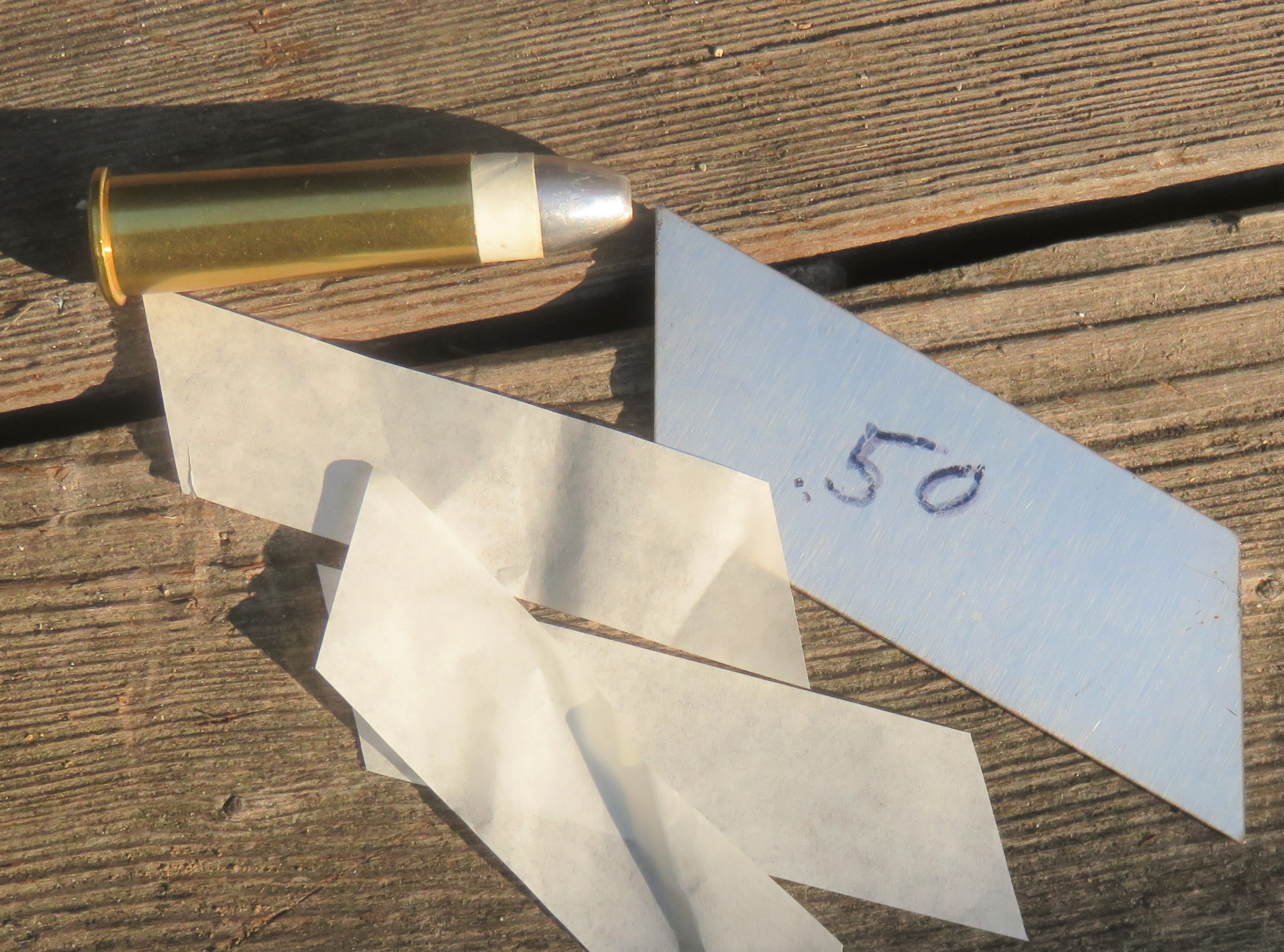
There are various ways of cutting the patches and I do recommend two books on paper patching; one is The Paper Jacket by Paul Matthews and the other is Loading and Shooting Paper Patched Bullets by Randolph Wright. Methods of cutting the patches are shown in both books and if you are cutting patches in quantity. you’ll find advantages in following their examples. For myself, my patch paper sheets are cut into strips using a paper cutter. The width of the strips is simply dependent on what the length of the bullets are which the patches are for. Focusing on these 473-grain bullets for the .50, I’ll cut the strips with a width of 7/8-inch. Each sheet of patching paper will provide several strips and usually three patches for the .50 can be cut from each strip.
Next, because I don’t cut a big supply of patches each time, I simply cut the patches out by using the patch template along with a sharp pair of scissors. The strips can be held rather easily as many as three at a time and that cuts three patches at once. While this is not as fast as other methods, there is no set-up time and cutting the patches with scissors keeps me in ammo quite nicely.
Now, let’s talk about patching the bullets or applying the paper patches. There are two ways of doing this; with the patch wet or dry. I know several shooters who apply the patches dry and they simply patch each bullet just before seating it into the waiting prepared cartridge case. My preferred way to patch the bullets is to dampen the patches and apply them, then wait for the patches to dry before loading them into the “primer-ed and powdered” cases.
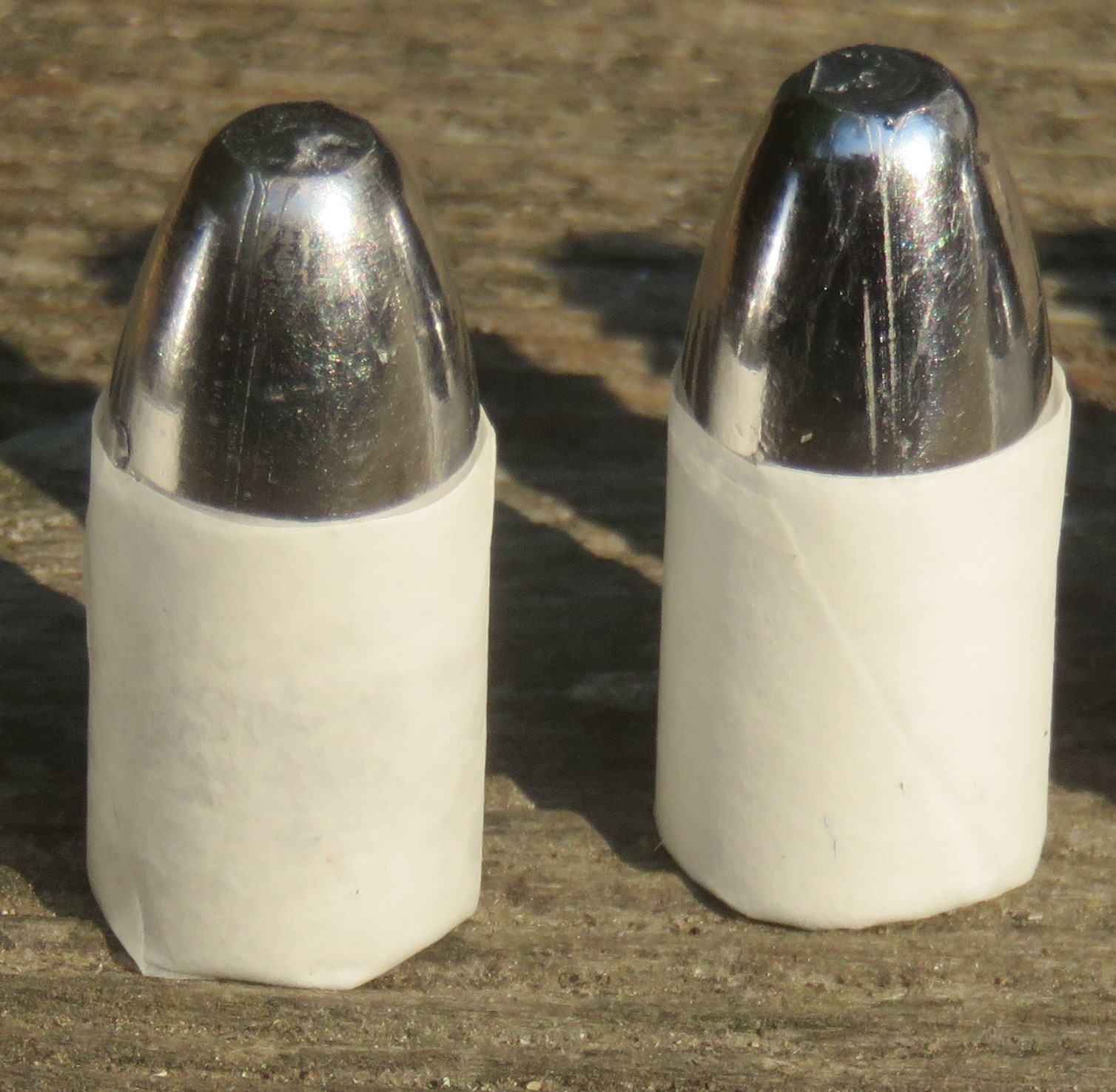
Some shooters use a paper patching board for applying the patches to the bullets. The small boards have indications where the patch should be laid as well as guides for where to put the bullets. Then, with the patch and the bullet in proper place, they are rolled together until the patch is wrapped around the bullet twice. Using the patching boards is a way to get very nicely patched bullets, very uniformly done. I admit that I admire the good-looking loads those who use the patching boards can make.
On the other hand, I prefer to simply hold the patch to the bullet where it should be and then roll the bullet “down my finger” to wrap the damp patch around the bullet. I’m not trying to say I’m an expert at it and I do ruin some patches from time to time. But I’ve been doing it this way for forty years and to me, using the patching board is just one more thing to hang on to, it gets in the way.
So, apply the patches as you can do it best, getting two complete wraps but with no overlap. The two thickness of patching should be as uniform as possible with no gap at the “seam” and no overlap either. Once the bullet is wrapped, continue turning the bullet to twist the bit of patching below the bullet, called the “skirt” by Randolph Wright, into the cup base of the bullet. If the skirt is long, twist it into a tail and then cut if off close to the base of the bullet.
With the bullets patched, they can be stood on their bases to allow some drying time. The drying does not take long but I often save the loading of the newly paper patched bullets for the following day.
We talked about loading with paper patched bullets in the 5th chapter of Black Powder Cartridge Reloading but we didn’t talk about either making or patching the bullets. And now we’ll talk about doing some loading but this time we’ll be doing things differently than what has been mentioned before. In addition to loading the bullets somewhat differently, we’ll be using a different cartridge, the .50-70 instead of the .45-70.
While shooting the .50-70 with some recently reloaded cartridges, at least a few of those cartridges were hard to chamber. They chambered just fine except for the last tiny little bit. Then they had to be forced completely in before the block of the Sharps rifle could be raised or closed in order to shoot the round. That is a possible indication of stretched cases which meant it was time to check all of my .50/70 Starline brass for length.
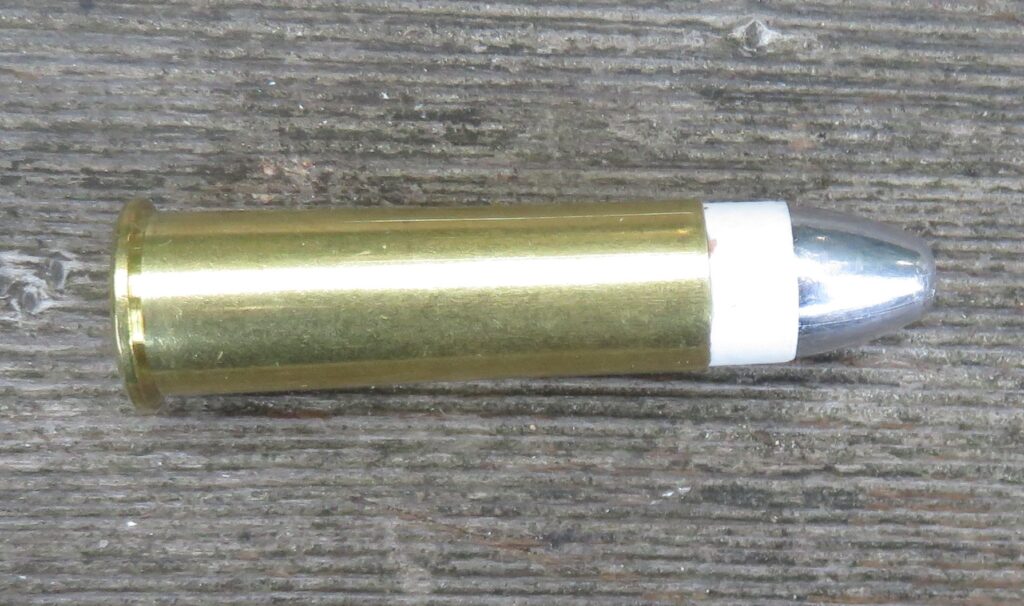
The way I do that is with a file trim die, by RCBS. And in order to use the file trim die, the cases must be re-sized. After re-sizing and trimming, which some of those cases certainly did need, the loading continued by running the brass cases through the expander die.
At this point the cases could have been primed, charged with powder and wad, and then re-sized again before twisting in the paper patched bullets. This would produce ammo as described previously but rather than do that, the brass was primed and prepared for loading after being expanded. For this example, that meant charging the cases with 63 grains of 1 ½ Fg Swiss powder, the .060” wad, and the 1/8”-plus of grease to go under the bullets. Some compression of the powder was required before adding that lube and then the bullets were pushed into the case just with firm fingertip pressure. With those bullets “seated” down so the lube was forced into the cup base of the bullets, the loaded cases were run through a taper crimp die. That prepared the paper patched .50-70 loads for shooting.
If you are going to order a taper crimp die from one of the makers, mine is from CH4D (www.ch4d.com), be sure to tell them if you want the die to be used with paper patched bullets. Because the paper patched bullets are somewhat smaller in diameter than the “greasers,” the die maker will give the taper crimp dies for paper patched bullets a slightly tighter crimp than for the standard or non-paper patched loads.
The 63-grain loading was itself a product of a little “tweaking,” trying for the best loading. Previously a 65-grain load was being used under the 450-grain grease-groove bullets and when the 473-grain bullets were considered, the powder charge was dropped to 60 grains with the hopes of finding a good grouping load with slightly lower recoil. The 60-grain loads did not perform as hoped. So, the powder charge was raised by just one grain, to 61 grains, and tried again. That didn’t perform any better and, in fact, both the 60- and 61-grain loadings didn’t sound right. They didn’t have the full “boom” of the .50. Now the 63-grain loadings will be tried. Wish me luck!



